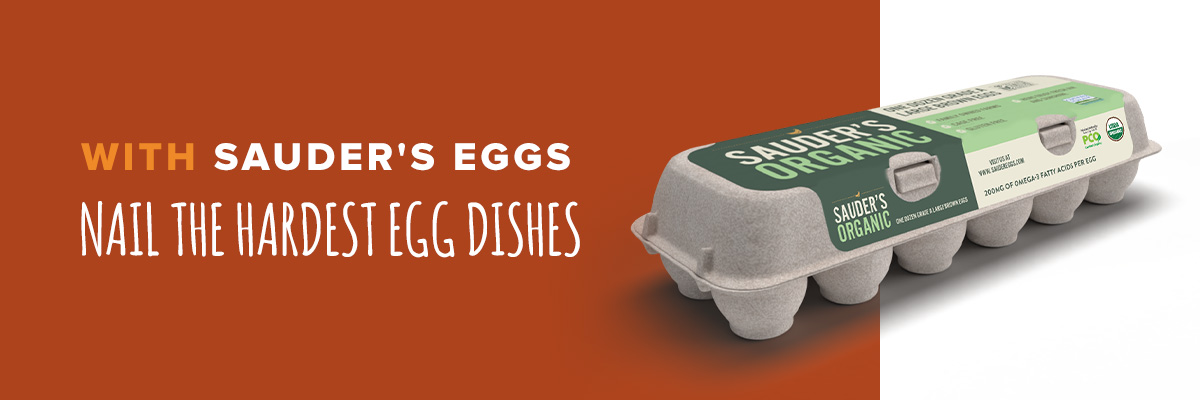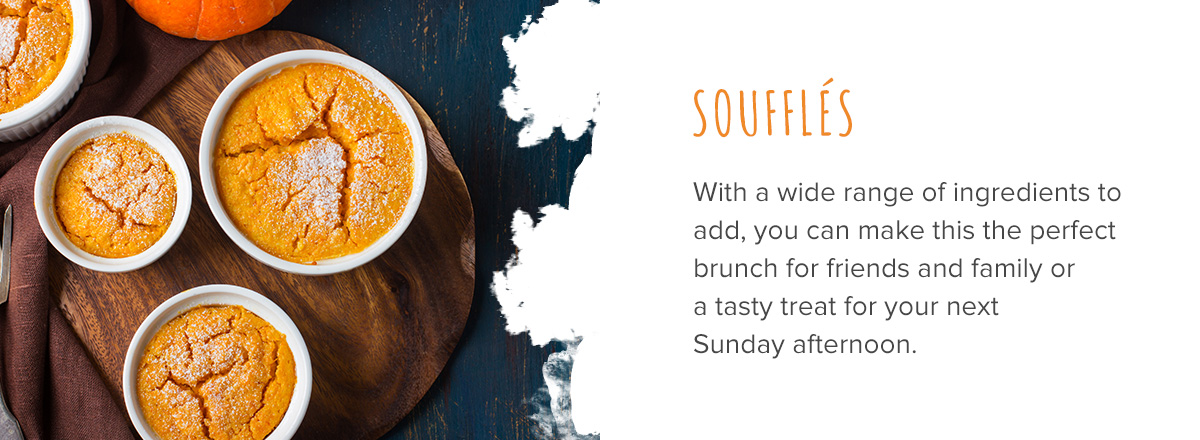How to Nail the Hardest Egg Dishes
Posted on: August 22nd 2022
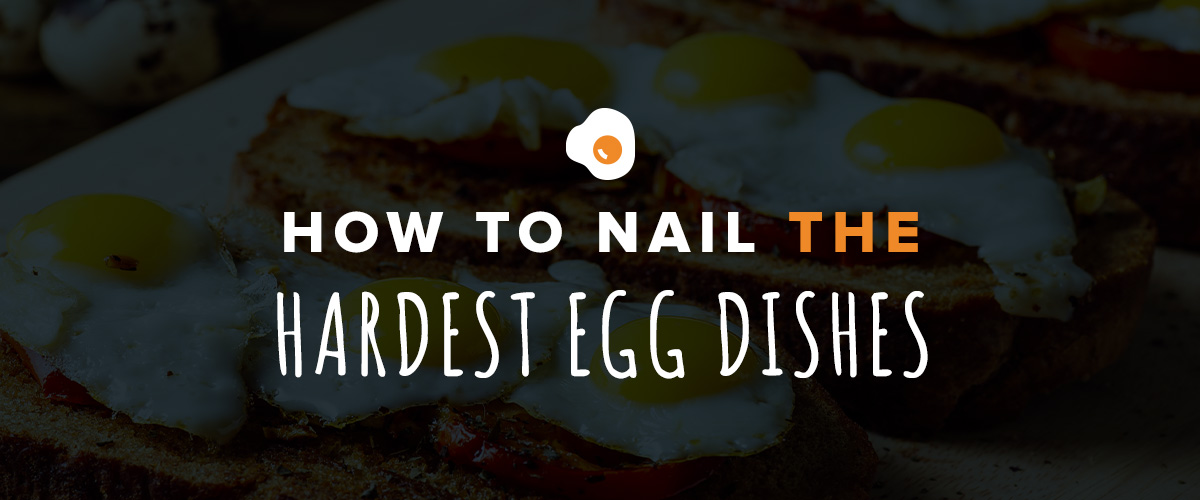
There are tons of ways to prepare eggs. Some people prefer scrambled eggs with cheese, while others like avocado and over easy eggs on toast. However, there are plenty of other tasty egg dishes you can make to treat yourself or your loved ones and get all the health benefits of these tasty treats.
If you’ve mastered the egg flip, perfected the scramble, and had your fill of toast variations, it might be time to try your hand at making some of the most difficult egg dishes out there. From timing how long you cook them to preparing a hearty breakfast with many ingredients, making eggs can be a worthwhile challenge that results in a flavorful dish that starts your morning on the right foot.
We’ve crafted a list of some of the toughest egg dishes to prepare. Some of these recipes require much more attention than others, but all of them will take a few tries to truly master. Check out these recipes and give a new difficult egg dish a try.
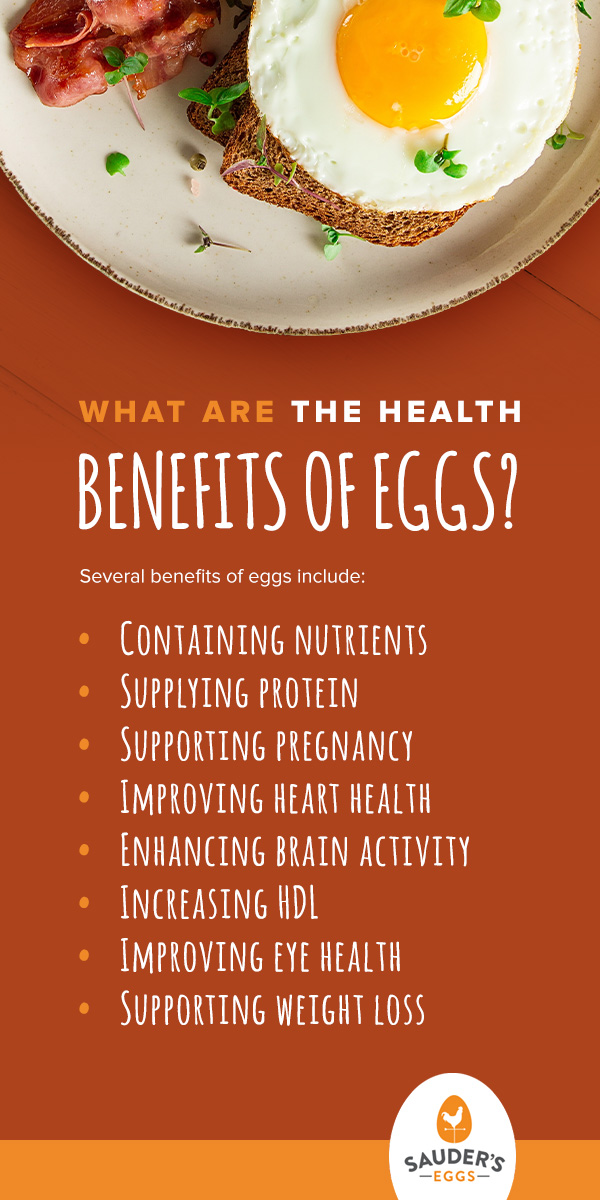
What Are the Health Benefits of Eggs?
Whether you’re looking into egg-based diets or just want to spice up your morning routine, eating eggs is great for your health. You can treat yourself to a morning scramble or an Eggs Benedict brunch and enjoy the delicious flavors of a nutritious meal. Eggs and egg whites have healthy amounts of cholesterol, proteins, and other essential nutrients that aid in preserving health and boosting brain functions.
Several benefits of eggs include:
- Containing nutrients: Yolks and whites have minerals, proteins, and vitamins that are beneficial for your body.
- Supplying protein: Protein gives people the energy they need to perform challenging tasks, such as working out. Eating just one egg supports muscle mass and lowers blood pressure.
- Supporting pregnancy: Pregnant mothers can support their infants’ brain development by eating eggs. Eggs can help develop strong babies in the womb, and infants can obtain the benefits of eggs in breastmilk.
- Improving heart health: The vitamins and minerals in eggs help reduce the chance of heart-related problems, such as strokes and heart disease.
- Enhancing brain activity: Choline is a basic compound that supports brain development and builds cell membranes. Eggs are rich in choline, making them great for improving brain health.
- Increasing HDL: High-density lipoprotein (HDL) is a source of good cholesterol, and eating eggs can help you increase the amount of HDL in your body. HDL effectively protects you from various afflictions and reduces the chance of heat-related diseases.
- Improving eye health: There are tons of antioxidants in these savory treats. These antioxidants help preserve eye health by counteracting issues such as cataracts.
- Supporting weight loss: Eggs are low-calorie snacks or meals you can have any time of the day. They’re also filling, enabling you to go longer without eating or snacking in between meals and helping you lose weight.
Overall, incorporating eggs into your diet is a delicious and healthy decision, especially because eggs can be the base for so many amazing meals. If you’re up for a challenge in the kitchen, check out some of the trickiest egg dishes to master:
1. Soufflés
A soufflé is a light and fluffy dish that works perfectly with both sweet and savory flavor profiles. With a wide range of ingredients to add, you can make this the perfect brunch for friends and family or a tasty treat for your next Sunday afternoon.
This dish is complicated because you must balance the seasonings to ensure they’re not overwhelming or too bland. The egg whites present another challenge, as you must whisk them to the correct stiffness so that they puff up in the oven. Timing can become an obstacle if you cook other dishes for the same meal at the same time. You also must serve and eat soufflé when it’s fresh for the fluffy flavors to stay crispy and firm.
When whisking the whites, be gentle and form a generous froth. Pick up the pace as the whites grow. It’s essential not to over-whisk the whites because they may separate and curdle. When the foam creates a short peak as you lift the whisk, you can begin folding the mixture.
Use a rubber spatula to gently fold half the mixture by cutting it in half and lifting it from the bottom. Once the mixture is smooth, you can place it in the oven or wait up to 15 minutes while preparing other dishes. You should immediately serve your dish to avoid the soufflé from caving in.
Here are some helpful tips for making soufflé:
- The egg whites should be at room temperature before placing the dish in the oven.
- Expect to use about one and a half egg whites per person eating the dish.
- Adding salt can help break up the egg whites.
- Eat soufflé as soon as it’s out of the oven for the fresh, puffy taste and texture.
- You can prepare the mixture and store it for up to two days before cooking for an event.
- Gently fold in vegetables and other ingredients right before cooking.
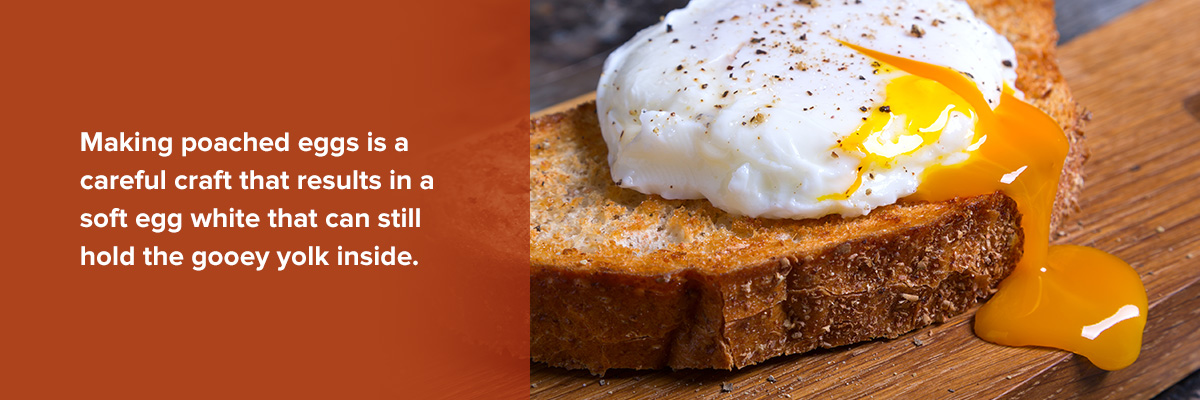
2. Poached Eggs
Making poached eggs is a careful craft that results in a soft egg white that can still hold the gooey yolk inside. When you cut into these eggs, the vibrant yolk runs out. These eggs are similar to cobbled eggs, but you submerge them in water instead of cooking them in a small container.
Poached eggs are a complex egg dish because they require careful cooking and placement. Without the proper cooking method, the eggs can break and turn your meal into a watery mess. You have to time your eggs to match your yolk preferences and carefully place and remove them from the water.
Many people attempt to create poached eggs with the swirling vortex method. This strategy can give you one spherical egg but won’t yield exceptional results if you’re trying to prepare a meal for your entire family. Without the vortex, your eggs may not be perfectly spherical, but they’ll hold their shape, and you can cook many at once.
Prepare your cooking station by filling a pot with about 4 inches of water. Bring the water to a boil, then lower the heat for the eggs. If you prefer to use vinegar, add one tablespoon before you put in your eggs. Use a mesh sieve to remove the liquid white that creates the whispies and lower the eggs carefully into the pot.
You only need to poach your eggs for three or four minutes. If you prefer a runny yolk, remove the egg sooner. Keep the egg in a minute or two longer for a firm egg. If you’re preparing the eggs for another day, remove them sooner rather than later because they’ll firm up when you reheat them. Enjoy your eggs hot or place them in an ice water bath and store them for up to two days.
Check out a few top tips for cooking poached eggs:
- Crack your egg into a ramekin and lower it into the water instead of cracking it directly into the pot.
- Use a deeper pot to allow the yolk to fall without flattening.
- Removing your egg with a mesh sieve will help remove the small white whispies you don’t want in your meal.
- Don’t put salt in your water because it can create more whispies that float away from the egg.
- Use a paper towel to remove excess liquid from your egg before eating it.
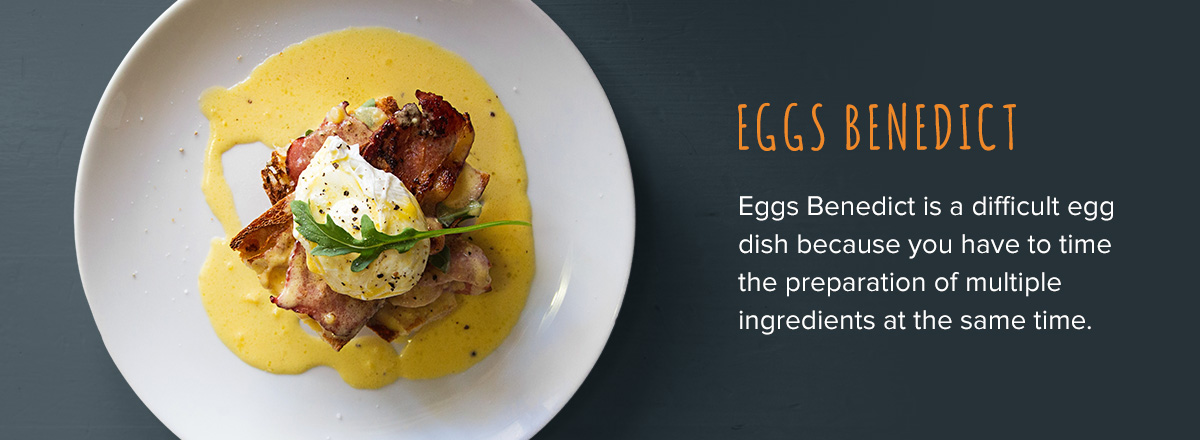
3. Eggs Benedict
Eggs Benedict is the way to go for a savory, filling meal. This classic dish uses a creamy hollandaise sauce, crispy Canadian bacon, and freshly toasted English muffins. This dish’s intensity and time make it great for special occasions like birthdays and holidays.
Eggs Benedict is a difficult egg dish because you have to time the preparation of multiple ingredients at the same time. This recipe requires poached eggs, and if you don’t know how to nail those yet, we have some tips and tricks listed above. For now, we’ll focus on preparing the rest of the elements to make a perfect eggs Benedict.
Making the Hollandaise Sauce
Begin your dish by preparing the Canadian bacon and hollandaise sauce. To prepare the Canadian bacon, fry it until both sides are brown. If you finish the bacon well before the rest of the meal, place it on a baking sheet and keep it in your oven at the lowest heat until you’re ready to assemble and serve everything.
The hollandaise sauce may be the most intimidating aspect of this dish, but you can create it in a few ways. For an authentic taste, prepare the sauce on the stove. For beginners still perfecting timing, you can use a blender and store the sauce in a warm location until you’re ready to pour it.
Blender instructions:
- Pour three egg yolks into a blender and blend for about 30 seconds.
- Gently melt the butter, so it’s warm but doesn’t cook the eggs or break the sauce.
- Continue blending the yolks as you add the melted butter.
- Season the sauce with salt, pepper, and lemon juice to taste.
Stovetop instructions:
- Create a double stovetop boiler with a bowl.
- Combine egg yolks, dry mustard, and lemon juice in the bowl.
- Continue to stir the mixture until thick.
As you prepare the rest of the components, keep the sauce warm in a pot on your stove.
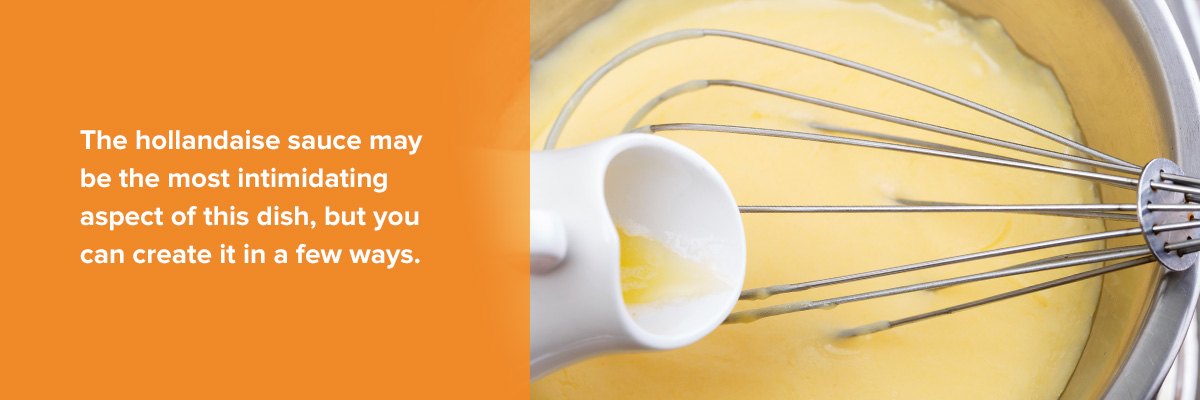
Preparing the Dish
The eggs and muffins only take a few minutes to prepare, so you should be just about finished with your Canadian bacon and hollandaise sauce while you get the rest of the ingredients ready.
Prepare the poached eggs to your preference. Toast and butter your muffins while poaching your eggs. Once done, lay one piece of Canadian bacon on each muffin and top with the eggs and hollandaise sauce. Serve hot and enjoy the runny goodness of your perfect eggs Benedict.
Here are a few tricks for making the perfect eggs Benedict:
- Overcooking can cause the hollandaise sauce to break.
- Quickly adding too much butter can result in a greasy or curdled sauce.
- You can substitute Canadian bacon with ham, spinach, bacon, or salmon.
- Transfer your cooked Canadian bacon onto a paper towel before serving to absorb excess grease.
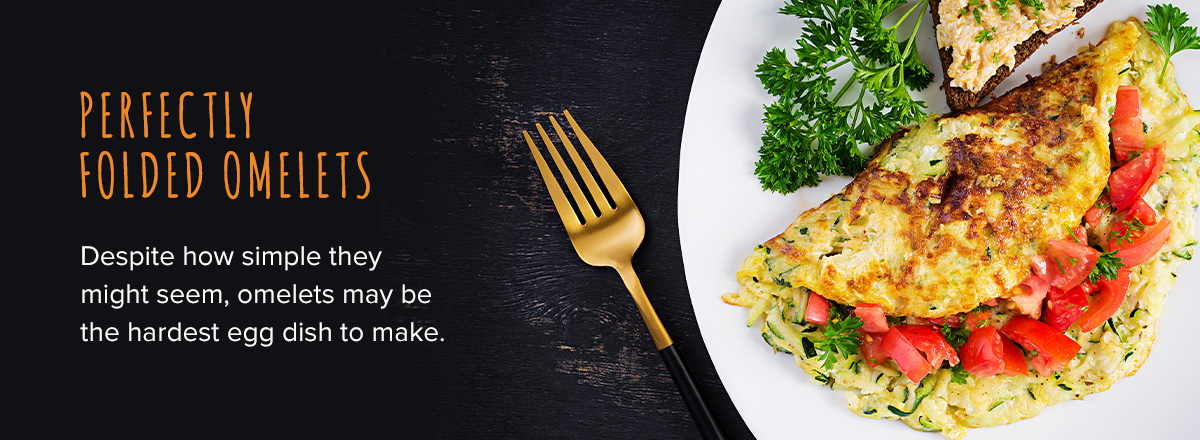
5. Perfectly Folded Omelets
Despite how simple they might seem, omelets may be the hardest egg dish to make. The best part of these eggs is that you can pack them full of veggies, cheese, and protein to make a nutritious and delicious meal any morning. However, it can be challenging to get the perfect omelet fold that captures the flavor of your fixings without burning the egg or having it crumble apart.
When you start to prepare your omelet, begin with a farm-fresh egg. These eggs have additional nutritional value, making them healthier and better for your diet. Prepare a small, heavy skillet and heat it so a drop of water sizzles. A heavy skillet will ensure the heat distribution is even, and the small size will keep your omelet fluffy and thick.
Many people place their fixings on top of the egg and let them get warm for a few minutes. Instead, you should saute your veggies and protein before cooking your egg. Leave the veggies and meat in the pan and pour your egg on top so the omelet cooks around them.
The key to the perfect omelet is the way you flip or fold it. Some people attempt to flip the egg so it cooks on both sides, but this can be challenging if you’ve loaded your omelet with other ingredients. Instead of lifting the egg from the pan, you want to use a spoon or spatula to pull the runny egg into the pan around the other ingredients.
When your egg is barely runny on the surface, lift the pan by the handle and use a spoon or spatula to flip a third of the omelet. Then, flip the other side the same way so there’s a crease in the middle of the omelet. When you’re ready to plate your dish, use your pan to flip the omelet upside down, so the crease is facing the plate.
See a few tips on how to make the perfect folded omelet:
- Cook your fixings before your egg.
- Leave the heat on low to avoid burning the omelet.
- Don’t flip the egg to cook the other side.
- Use a spoon or spatula to pull the uncooked egg onto the pan.
- Lift the left side of the omelet to fold.
- Lift the right side of the omelet to fold.
- Plate the omelet with the crease facing the plate.
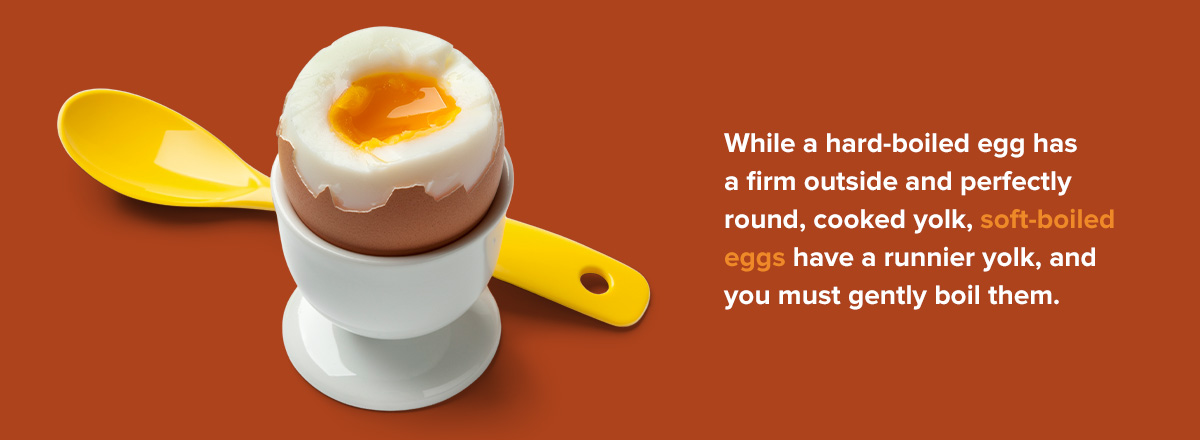
6. Soft-Boiled Eggs
A soft-boiled egg can be a savory standalone snack or an excellent topping on salads, ramen, soup, and vegetables. Although these don’t take long to make, nailing the timing can be tricky. While a hard-boiled egg has a firm outside and perfectly round, cooked yolk, soft-boiled eggs have a runnier yolk, and you must gently boil them.
Preparation for this dish is simple. All you need is a boiling pot of water and as many eggs as you want to cook. Keep the eggs intact in their shells. All of the eggs should be completely submerged in the water and create a single layer at the bottom of the pot.
Be sure to time your soft-boiled eggs. Even a minute more than you intend can turn your eggs from soft to medium. Six minutes is generally enough time to cook the egg’s outer layer while leaving the inside gooey. If you boil your eggs for less than five minutes, the whites may not be able to set, and you’ll have trouble peeling the shell without ruining the egg.
Experimenting with one or two eggs may be best before cooking an entire carton. After five minutes, take one egg out, cool it with cold water, and peel it. If it’s too runny, wait a minute and pull the second egg out. More than seven minutes will likely result in a stiffer outer yolk, and you won’t have the soft-boiled egg you’re craving.
Here are more tips for cooking soft-boiled eggs:
- Experiment with one or two eggs before making an entire batch.
- Ensure the water is boiling before dropping the eggs.
- Only use enough eggs to cover the bottom of the pot.
- Use a timer to monitor how long your eggs are boiling.
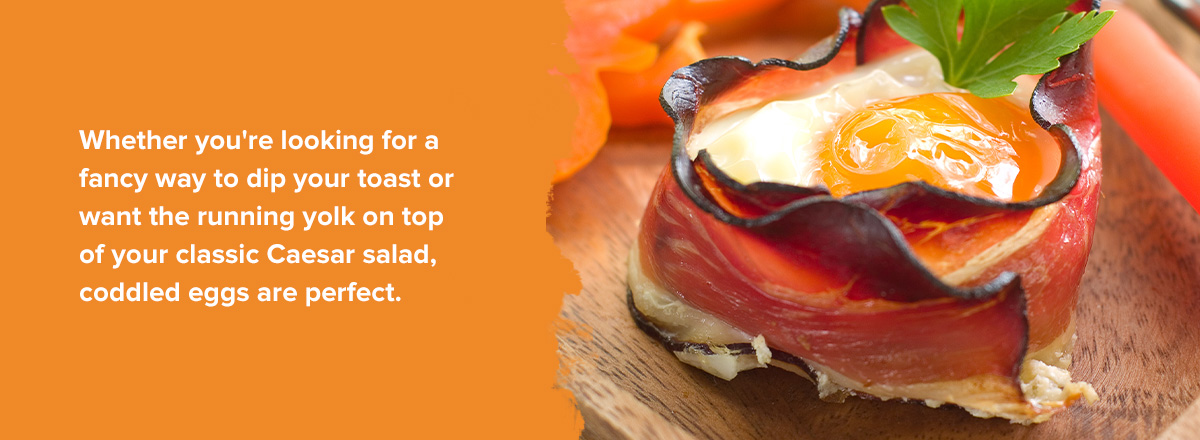
7. Coddled Eggs
Whether you’re looking for a fancy way to dip your toast or want the running yolk on top of your classic Caesar salad, coddled eggs are perfect. These eggs won’t hold their shape, but they make for excellent dipping or pouring.
Many cooks find coddled eggs to be a hard egg dish because it takes a slow cook to prepare these eggs to perfection. You have to ensure you cook the yolks to your liking and have the proper instruments to achieve coddled eggs’ gooey and creamy goodness.
Before you think about preparation, you must ensure you have an egg coddler. This ceramic dish will keep your egg from coming in contact with the water. It has a screw-on lid that allows you to take your eggs from the pot to the plate without extra dishes. If you don’t have a coddler, you can use a ramekin and the pot lid to steam, but the result will appear more like a poached egg than a coddled egg.
You’ll also need a small pan that can hold enough water to cover the edges of the coddler. Fill this pot with water and heat it on medium-high heat until the water is boiling. While the water is warming, prepare your coddler by smearing butter on the inside and adding a small amount of heavy cream.
You can season the inside of the coddler and add other ingredients, such as bacon or mushrooms, if you prefer the additional flavor. Crack one egg into the coddler and repeat the process with as many eggs as you want to make.
Ensure the lid is tightly on the coddler and place the dish in the boiling water. Reduce the heat to medium and allow the eggs to simmer. Let the eggs cook for about five minutes if you prefer a runny yolk. If you like harder eggs, keep them in the water for about 10 minutes. Carefully remove the eggs when finished and serve immediately.
See more tricks for preparing coddled eggs:
- Invest in a coddler for proper cooking and gooey results.
- Sauté or cook additional ingredients before adding them to the coddler.
- Ensure the water is boiling before placing the eggs inside the pot.
- Check your egg whites by jiggling the coddler and monitoring their movement.
Nail the Hardest Egg Dishes With Sauder’s Eggs
Sauder’s Eggs is a family-owned business dedicated to quality and fair prices. What started as a door-to-door business has transformed into one of the top wholesaling businesses in the nation, selling about 1.5 billion eggs every year.
We’re proud of our relationships and want to create one with you, too. Whether you’re looking to become part of our team or searching for high-quality eggs, we’ll treat your family like ours.
Browse more of our egg recipes and try your hand at a new challenging egg dish. Contact us to find where you can buy our eggs and enjoy your next meal with farm-fresh ingredients.
